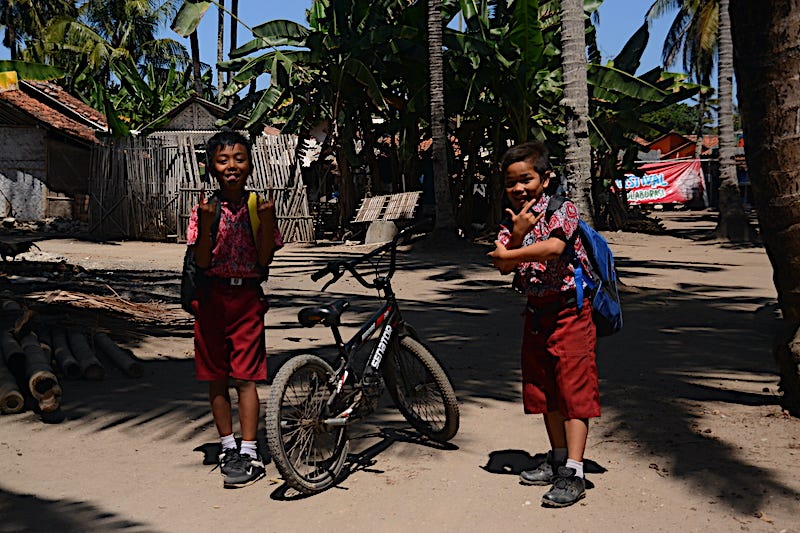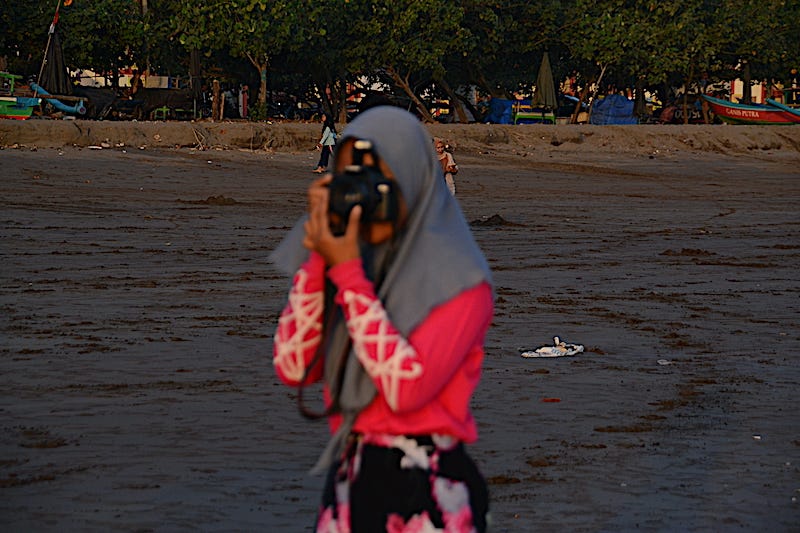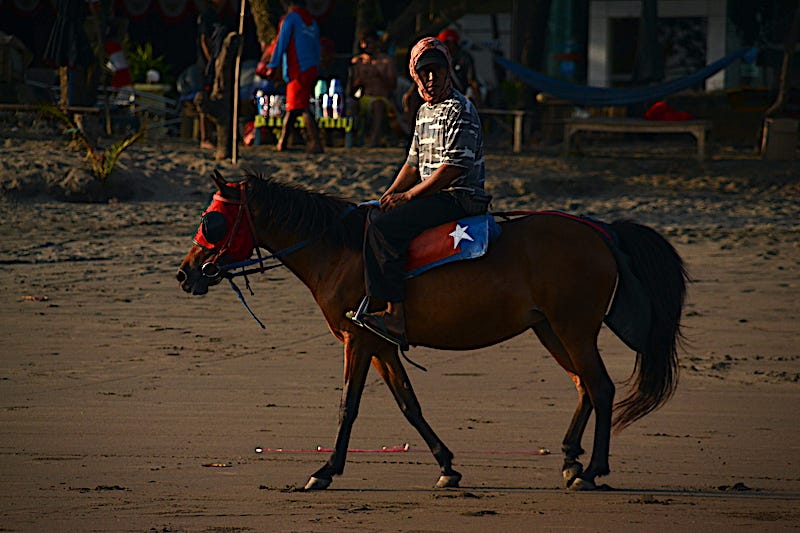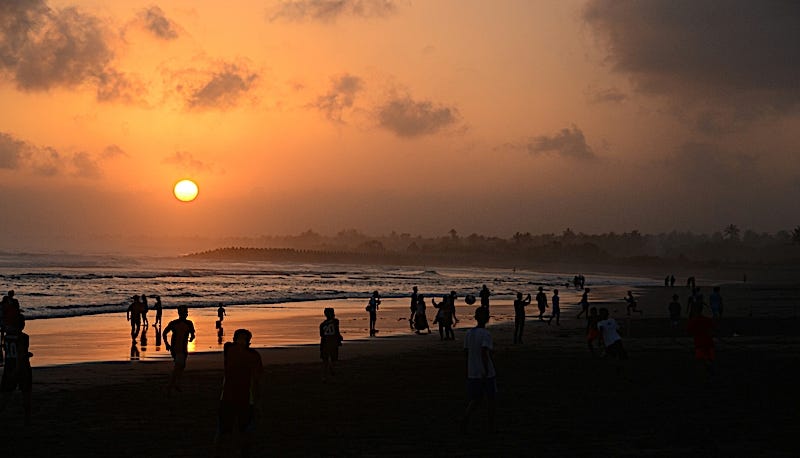Sonos Ikea Symfonisk Trueplay On and Around the Beach
A Morning Space Recognition Session and Evening Frolics on the Beach
The music is by:
Adrian Schneider, an electronic musician that showcases a blend of organic sounds and modern synthesis.
Symbolico, an Israeli music producer known for his contributions to the dance music genre.
John Butler, an acclaimed Australian musician and songwriter known for his unique blend of roots, blues, and folk music.
Whenever I move my “Sonos” speaker to a new room, it spends some time playing music before its “Trueplay” feature kicks in, sending out echolocation tentacles to fine-tune the sound to match the room’s acoustics. Not all “Sonos” speakers are this curious—some stick to their default settings, indifferent to their environment, while others require manual initiation of echolocation procedures.
It’s a bit like people. Some remain unfazed by their surroundings, comfortable doing their thing wherever they are. Others rely on maps and guidebooks, recalibrating themselves with careful preparation. And then there are those who, upon arriving in a new space, play a few songs and start searching for a new vibe, adjusting their inner compass to match the space around.
Being of the latter type, I ventured out for a morning space-recognition session before breakfast. What initially seemed to be just another seaside resort, gradually revealed its true face of a traditional fishing village, tucked onto a narrow isthmus* which extends into a peninsula entirely occupied by an overpriced National Park.
Had I settled for the default image of Pandangaran—the stretch between my hostel gate and the ocean just across the road—I would have missed the richness of the world hidden behind the beachfront. The world where ripe mangoes lie waiting to be plucked off the ground along quiet streets, where gap-toothed children run barefoot in the shade of palm trees along red-clay alleys, and where armies of silver and peach-hued fish, lined up neatly on netted tables, surrender their last drop of life-giving moisture to the relentless sun on the eastern side of the isthmus. Without the “Trueplay” feature in my inner Sonos, none of this world would have truly become my Pandangaran.
It strikes me that reality is composed of many layers. It’s our operating systems, along with our choice of apps and features, that shape the contours and flavours of our experiences. I once identified as “Technics Dolby Surround ProLogic,” but now I find myself as a “Sonos Ikea Symfonisk,” equipped with the “Trueplay” tuning feature. Who knows what interactive interface lies ahead? Much remains uncertain and little stays constant. Reality isn’t a brick set on a patch of concrete, but a quantum field of limitless potential.
Are we satisfied with merely scrutinising the wall before us, or do we yearn to penetrate its structure? Do we wish to remain in the outdated world of Dolby Surround, or embrace the innovative realm of Trueplay spatial acoustics recognition system? In fact, what we seek for genuine happiness is maximum compatibility and optimal alignment—a destination best reached from the vast expanse behind closed eyes, within a mind at rest.
The truth is, there’s nothing inherently wrong with the palpable reality of the solid brick firmly cemented onto a patch of concrete. It’s more than just an inconvenient obstruction, but it serves its purpose, holding value within the greater design, much like like beachfronts. Were it not for this relentless Trueplay compulsion to recalibrate my bearings, I’d eagerly surrender to an uncompromising sojourn on that foreign planet of beating waves and cawing seagulls across the road. I’d gladly embrace a full-immersion baptism.**
Unfortunately for my full-immersion fancy, and fortunately for Pangandarians, the largest non-island resort in Java has managed to keep its beach-facing huts untouched by tourist invasion. Here, the constant roar of waves and the cries of seagulls are reserved for exclusive use of beachfront hens, deer-like males and stray dogs. Last night, we ventured to ask the beach people if they would consider hosting tourists eager for a night or two in close proximity to the sea. However, it turned out that what might seem like the perfect room with a view of the Indian Ocean currently serves as a chicken coop or goat pen.
Good for you, you happy domesticated beachfront fowl. Keep scratching the fine white sands in search of beach grubs! And good for you, you frisky, trouble-prone rascals. Keep performing your mating dances to the rhythm of crashing waves! Meanwhile, we will humbly retreat to our hostel behind the road.
It seems that holidaymakers here are busy from 9 to 5 doing their holiday things away from the beach, but at around 5.30 p.m., they flock back to the ocean’s edge. Now, at 6 p.m., amidst the throngs of blissful beachgoers, a herd of male deer has claimed a sizable portion of the sand. They’re engaged in a captivating display of mock battles, vying for the attention of their ladies lounging in the shade of palm trees at the deep end of the beach.
Surprisingly, no one is overly interested in this unusual spectacle. So, we snap pictures of the sparring deer while the other vacationers are busy snapping pictures of us photographing the deer.
There's something for everyone,
On the shores of Pangandaran.
From sunlit sands to playful waves,
A paradise where joy engraves.
It seems that many tourist spots in Asia thrive not only on their intrinsic charm but also on the allure of white foreigners. I imagine that Asian tourists arrive from distant provinces to explore famous attractions, only to encounter the delightful bonus of pink-skinned, blue-eyed individuals. Their curious “look at what this man has on his head and in his eyes” wonderment is hardly surprising. After all, we too seek out exotic-looking Asians, so why wouldn’t they look for the extraordinary in us? As long as we wield cameras instead of machine guns, all’s well and gula-gula melekatkan!
This evening has also beckoned hundreds of teenagers to the expansive, low-tide middle section of the beach, where they engage in spirited football matches. It’s a stunning sight—vibrant T-shirts splash the landscape with color, illuminated by the warm orange glow of the setting sun. All of this is bathed in a romantic mist of incessantly breathing waves, harmonising with the distant wails of muezzins, blending into a harmonious cacophony.
As we sit, watching the sun’s swift descent, we listen to the lively hum of two distinct traffic lanes flanking the makeshift football pitches. The lane closest to the waves is haven for couples strolling romantically, selfie sticks in hands. Meanwhile, the lane farther from the water is overtaken by hired horses and motocross motorcycles, piloted by less-than-competent one-off riders.
All this colourful commotion concludes at around 7 p.m. and the beach is again left alone with the tirelessly beating waves.
To top off this seaside beauty, and given my expertise in savoring five-course Indonesian meals, I’d like to share a recipe for an unforgettable Pangandaran dinner—five delectable courses, each sourced from a different local eatery, all for the astonishing total of just $2.60:
Start your culinary adventure with a delicious serving of Batagor for just 35 cents. Then, take a leisurely stroll to indulge in Cilok, another delightful treat at the same bargain price. As you savour these treats, let your eyes be tempted by the vibrant hues of Asgar Liar cookies—the bright green is a must-try, followed by the pink banana flavor and the spaghetti-like yellow—each at only 6 cents. Chase it all down with Es Cendol for another 35 cents.

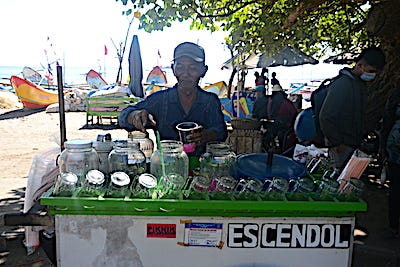

Next, head over to the other side of the isthmus—or anywhere your heart desires—and plunge into the refreshing, roaring waves of the Indian Ocean to cool down a bit. Once out of water, develop a craving for Siomay, stand tall, and with “desires wet with unrequited lust,”*** channel your inner Medea as you cry out: “I am dragged along by a strange new force. Desire and reason are pulling in different directions. I see the right way and approve it, but follow the wrong.”****
Finally, with a renewed sense of purpose, stride confidently toward the beach entrance, order your Siomay, and part with the final $1.37. Now, not only you are $2.60 lighter, but you are also heavy enough to make you question your ability to stay afloat on the backs of the raging of waves. Phew! It’s time to confront the unbridled gluttony with the potential of the third largest ocean on our beloved globe.
❈
When the ocean surges,
don’t let me just hear it.
Let it splash inside my chest!*****
❈
* Interestingly, the tombolo connecting the mainland to the Pananjung Peninsula narrows to roughly 100 metres (328 feet wide) near E. Jaga Lautan Street, offering a unique vantage point from which the Eastern Beach is visible from a specific spot on the Western Beach.
My compulsive “Sonos Trueplay” is particularly attuned to such peninsular see-across spectacles. One notable example is from Libek Hill on the Hel Peninsula in northern Poland. At just 12.5 metres (40 feet) high, you can spread your arms wide and enjoy a panoramic true spatial feast for “Trueplay”—just like on Jalan E. Jaga Lautan.
I once subjected my poor family to a 25-mile bike ride from Malmö to the Falsterbo Peninsula (Falsterbonäset) in Sweden’s southernmost county, all to show them the wrong side of the isthmus. While most Swedes flock to Höllviken for the Baltic's open, clean, and warm sea, framed by colorful Scandinavian beach huts, we arrived dog-tired and disoriented, only to find the musty port side of the isthmus. We couldn't help but feel that the peninsula's beauty was somewhat…overrated (sic!).
** Full-immersion baptism applies just as well to winter frolics in the snow. Up in the mountains, the higher the sleeping quarters, the more otherworldly the snow-covered landscape, and the deeper the immersion. A skiing or snowboarding holiday becomes more than just a winter sport—it’s a journey into a completely different, almost alien reality. It’s wild, often desolate, and you can build an igloo after dinner virtually anywhere you please. And, of course, the fewer steps between your bed and the slopes, the better.
*** Cf.: Maya Luna & Pattern Disrupt.
**** Ovid, Metamorphoses, Penguin Classics, 2004.
***** ”Put this Design in Your Carpet” cf. Coleman Barks, The Essential Rumi, HarperOne, 2004.
This is Magda’s polaroid based on Timbuktu No Comment and No Football.
And here is my comment:
In 2012, when Islamist groups such as Ansar Dine and Al-Qaeda in the Islamic Maghreb (AQIM) took control of Timbuktu and parts of northern Mali, they imposed a strict version of Sharia law, banning music, with Mali having such a strong musical heritage. The conservatist brutes destroyed instruments and threatened musicians, some of whom had to flee the region.
Football was also restricted or banned in public space. Public displays of any joy or entertainment were deemed un-Islamic under their interpretation of Sharia. I strongly recommend watching "Timbuktu," a 2014 film directed by Abderrahmane Sissako. It’s a poignant and powerful portrayal of life under Islamist militant rule in Timbuktu, inspired by the real events that occurred in northern Mali in 2012.
There will be more from Pangandaran next week. And remember my dear subscriber that whatever’s been published before, can be found in the archives. Also, if you can’t find my post on Monday next week, well… it will mean that I have gone to do the next thing that is making me tick at that moment I time….





